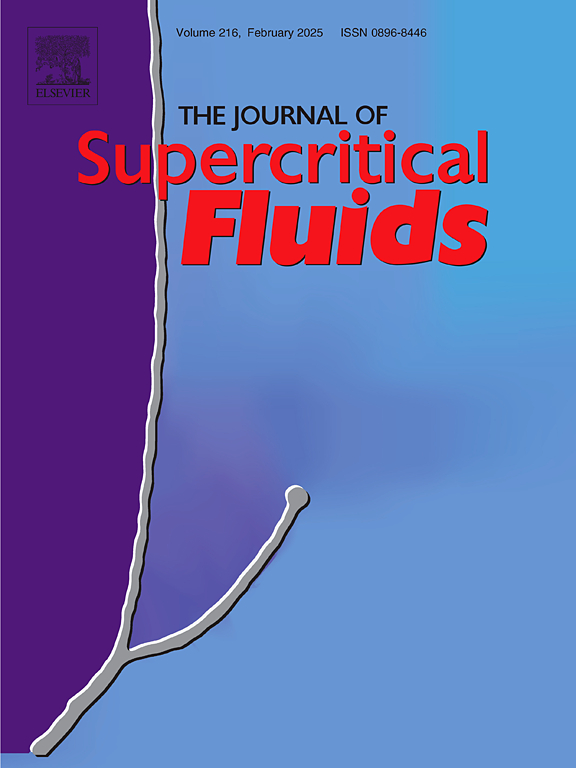Solubility of insect fat in compressed CO2: Experiments and density- as well as activity-based modeling
IF 4.4
3区 工程技术
Q2 CHEMISTRY, PHYSICAL
引用次数: 0
Abstract
As an important basis for the design of economic extraction processes, the solubility of insect fat in compressed CO2 was experimentally determined over a wide range of temperature (298–353 K) and pressure (15–60 MPa) using the gravimetric static-analytical method. The insect fat arises as a side-product from protein meal production from dried black soldier fly (Hermetia illucens) larvae. The solubility varied from 0.15 to 167 gfat/kgCO2 depending on the operation conditions. The obtained solubility data were correlated using 8 common semi-empirical density-based models involving 3–5 fitting parameters. Based on the enhancement factor concept and thermodynamic considerations, an extended semi-empirical model is proposed, which gives the best goodness of fit with an of 9.8 % despite the heterogeneity of the insect fat. An activity-based model (Expanded liquid theory) using a modified Wilson approach has also been considered, but did not lead to a better description of the solubility data with an of 14.2 %.
昆虫脂肪在压缩CO2中的溶解度:实验和密度-以及基于活动的建模
昆虫脂肪在压缩CO2中的溶解度是设计经济提取工艺的重要依据,在温度(298 ~ 353K)和压力(15 ~ 60MPa)范围内,采用重量静态分析法进行了实验测定。这种昆虫脂肪是干黑兵蝇(Hermetia illucens)幼虫生产蛋白粉的副产品。溶解度根据操作条件在0.15 ~ 167 gfat/kgCO2之间变化。得到的溶解度数据使用8个常见的半经验密度模型进行关联,涉及3到5个拟合参数。基于增强因子概念和热力学考虑,提出了一种扩展的半经验模型,尽管昆虫脂肪具有异质性,但其拟合优度为9.8%。也考虑了使用改进的Wilson方法的基于活度的模型(扩展液体理论),但由于AARD为14.2%,无法更好地描述溶解度数据。
本文章由计算机程序翻译,如有差异,请以英文原文为准。
求助全文
约1分钟内获得全文
求助全文
来源期刊

Journal of Supercritical Fluids
工程技术-工程:化工
CiteScore
7.60
自引率
10.30%
发文量
236
审稿时长
56 days
期刊介绍:
The Journal of Supercritical Fluids is an international journal devoted to the fundamental and applied aspects of supercritical fluids and processes. Its aim is to provide a focused platform for academic and industrial researchers to report their findings and to have ready access to the advances in this rapidly growing field. Its coverage is multidisciplinary and includes both basic and applied topics.
Thermodynamics and phase equilibria, reaction kinetics and rate processes, thermal and transport properties, and all topics related to processing such as separations (extraction, fractionation, purification, chromatography) nucleation and impregnation are within the scope. Accounts of specific engineering applications such as those encountered in food, fuel, natural products, minerals, pharmaceuticals and polymer industries are included. Topics related to high pressure equipment design, analytical techniques, sensors, and process control methodologies are also within the scope of the journal.
 求助内容:
求助内容: 应助结果提醒方式:
应助结果提醒方式:


